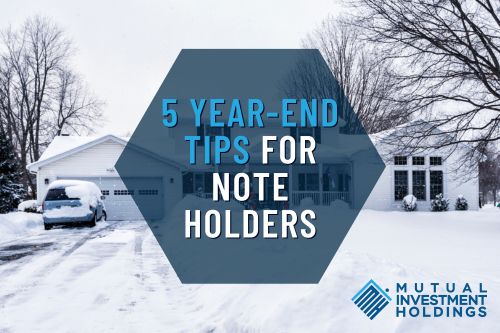With the year coming to close and a new one right around the corner, it’s time to do a little maintenance. This includes taking stock of your investments and real estate notes, which is why we have a few year-end tips for note holders that we follow every year.
Taking the time to verify that your note is in good standing as well as taking care of any required paperwork and valuations will start the year on the right foot.
5 Year-End Tips for Note Holders
With diligent work throughout the year, the end of the year doesn’t have to be hard. It’s all about checking that your note is current on taxes and insurances and fulfilling any legal requirements.
Verify Real Estate Taxes are Current
When it comes to holding a real estate note, often the first concern centers around “Is the buyer current on the monthly payments?”
But, are they also current on their real estate taxes? If the answer is no, then the note qualifies as defaulted — which is a note holder’s worst nightmare when you thought you held a performing note. It can also jeopardize your lien position since most real estate taxes take lien priority over a mortgage or trust deed.
Luckily, it’s easy to verify the status by checking the county records using the property address or tax parcel number. This verification can be done in person with the county tax assessor, over the phone or online.
Don’t find yourself in hot water because taxes were left unpaid by the buyer. Checking when taxes are due and at the end of the year can help prevent a backup of delinquent taxes, penalties and interest.
Verify Property Insurance is Current
While you’re looking at the tax status of your note, also check if there is current property insurance as a lapse in coverage can also lead to default.
Requiring a copy of the declaration page stating the buyer as the insured owner and the note holder as the insured mortgagee adequately proves the property insurance is current.
This can be obtained from the servicing company or directly from the payor/buyer if you are not using a company to service the note collection.
Year-End Note Statement
Like with other investments, a yearly statement should be prepared to let all parties know the standing of the real estate note. This keeps everyone on the same page as well as giving a “report card” of the performance of the note.
Your year-end note statement should include the following items:
- Starting Balance
- Ending Balance
- Amount of Interest Paid
- Amount to Principal
- Late Fees (if applicable)
- Servicing Fees (if applicable)
- Impound Accounting for Taxes & Insurance (if applicable)
Form-1098 Mortgage Interest Statement
Not just a good idea, it’s legally required in some situations.
Federal law requires that you provide Form-1098 to any individual from whom you receive $600 or more in mortgage interest during the calendar year in trade or business.
In situations where payments are made to third party escrow, collection, or a servicing company, the third-party should handle the filing. But, make sure to obtain a copy for your records.
Fair Market Valuations
When a note is held as an asset in a Self-Directed IRA, your custodian requires a fair market valuation (FMV) to file the reports required by the IRS.
Why?
The IRS uses the valuation to determine the Required Minimum Distribution for individuals over 70.5 years of age. But, what if your account doesn’t have an RMD? Your custodian still needs to report annually to the IRS with the asset valuation.
Sending a copy of the Year-end note statement and amortization schedule to the custodian along with their completed form is usually all it takes to satisfy this requirement on performing notes.

